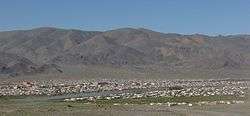Bayan-Ölgii Province
| Bayan-Ölgii Province Баян-Өлгий аймаг ᠪᠠᠶ᠋ᠠᠨᠥᠯᠦᠭᠡᠢᠠᠶᠢᠮᠠᠭ | |||
|---|---|---|---|
| Province | |||
|
| |||
| |||
 | |||
| Coordinates: 48°18′N 89°30′E / 48.300°N 89.500°ECoordinates: 48°18′N 89°30′E / 48.300°N 89.500°E | |||
| Country | Mongolia | ||
| Established | 1940 | ||
| Capital | Ölgii | ||
| Area | |||
| • Total | 45,704.89 km2 (17,646.76 sq mi) | ||
| Population (2013) | |||
| • Total | 90,404 | ||
| • Density | 2.0/km2 (5.1/sq mi) | ||
| Time zone | UTC+7 | ||
| Area code(s) | +976 (0)142 | ||
| ISO 3166 code | MN-071 | ||
| Vehicle registration | БӨ_ | ||
| Website |
www | ||
Bayan-Ölgii (Mongolian: Баян-Өлгий; Kazakh: Бай-Өлке, Rich cradle/region, alternately spelled Olgiy, Ulgii, etc.) is the westernmost of the 21 aimags (provinces) of Mongolia. The country's only Muslim and Kazakh-majority aimag, it was established in August 1940. Its capital is Ölgii.
Geography
The aimag is located in the extreme west of the country, and shares borders with both Russia and China. The border between the two neighbouring countries is very short here, though, and ends after about 40 km at the eastern end of Kazakhstan. Within Mongolia, the neighbouring aimags are Uvs in the north east and Khovd in the south east.
Bayan-Ölgii is the highest Mongolian aimag. For the most part it is located in the Mongolian Altay, at the transition point to the Russian Altay. About 10% of the territory are covered by forests, consisting primarily of Siberian Larch.
The Nairamdal Peak (also Friendship Peak, Chinese: Youyi Feng) of the Altai Tavan Bogd (five saints mountain) massif mountain marks the corner between the three neighbouring countries. About 2.5 km further south on the Mongolian-Chinese border, the Khüiten Peak is the highest point of Mongolia at a height of 4,374 m. The massif includes several glaciers, such as the 19 km Potanin Glacier, and is only accessible to experienced climbers with local guidance.
The Khovd River (the longest in the western Mongolian Great Lakes Depression) has its origin in this aimag. It is fed by the three lakes Khoton, Khurgan, and Dayan, and in turn feeds the lake Khar-Us Lake in the Khovd Aimag. The Tolbo Lake is a large saline lake about 50 km south of the aimag capital. It features clear and cold water on an elevation of 2,080 m.
Population
Most inhabitants of Bayan-Ölgii are Kazakhs (93%[1]). Smaller parts of the population are composed of Uriankhai, Dörvöd,[2] Khalkha, Tuva and Khoshuud. A significant portion of the population speaks Kazakh as their mother tongue and the Mongolian language only as a second language, if at all.
After democratization, many inhabitants moved to their historical homeland, Kazakhstan, assuming they would find a better future there. The result was a noticeable loss of population in 1991-1993, when approx. 80 thousands were repatriated to Kazakhstan. A noticeable number of former immigrants have been returning, so that the population has risen again.
| 1956 census |
1960 est. |
1963 census |
1969 census |
1975 est. |
1979 census |
1981 est. |
1985 est. |
1989 census |
1991 est. |
1993 est. |
1995 est. |
1998 est. |
2000 census |
2002 est. |
2004 est. |
2005 est. |
2008 est. |
2009 est. |
|---|---|---|---|---|---|---|---|---|---|---|---|---|---|---|---|---|---|---|
| 38,800 | 44,600 | 47,800 | 58,100 | 66,600 | 71,400 | 74,500 | 82,400 | 90,900 | 102,817 | 75,043 | 82,259 | 87,341 | 94,094 | 98,066 | 99,112 | 95,758 | 93,931 | 93,017 |
Culture

The culture of the Kazakh majority is strongly influenced by Islamic traditions. The mosque of Ölgii also houses the Islamic Center of Mongolia. It is placed at an unusual angle within the fabric of the city, because the building was oriented exactly towards Mecca. There's also a madrasah (Islamic school) at the same place.
The aimag is famous for the traditional practice of hunting with trained eagles.[10][11][12][13][14] The captive eagles work in a similar way as hunting falcons do. While eagles are used for hunting in other parts of the world, particularly Kazakhstan and Kyrgyzstan, the practice is most common in Bayan-Ölgii, where an estimated 80% of the world's eagle hunters live.[15] The annual Golden Eagle Festival is held in Ölgii every October to display the skill of eagle hunters, with about 70 hunters participating per year.[16][17]
Traffic
The Ölgii Airport (ULG/ZMUL) has one runway, unpaved until 2011. It offers regular flights to Ulaanbaatar and irregular flights to Ulaangom and Moron in Mongolia and Almaty in Kazakhstan.
A road connecting to Russia starts in Tsagaannuur.
The border with China is open only for a short time in the summer.
National parks
The Altai Tavan Bogd National Park covers 6,362 km² and is located south of the highest mountain of Mongolia. It includes the lakes Khoton, Khurgan, and Dayan. The protected area offers a home for many species of alpine animal, such as the Argali sheep, Ibex, Red deer, Beech marten, Moose, Snow cock, and Golden eagle.
The Khökh Serkhiin Nuruu Protected Area (659 km²) and the Siilkhemiin Nuruu National Park (1,428 km²) are of similar character.
The Develiin Aral Natural Reserve (103 km²) is established around Develiin Island at the confluence of the rivers Lsan Khooloi and Khovd. Since 2000 it has provided protection for various birds and animals including pheasants, boars, and beavers.
The Tsambagarav Uul National Park includes 1,115 km² of land around the glaciers near the Khovd aimag and protects the snow leopards living there, among others.
Administrative subdivisions

| Sum | Mongolian | Sum population (1985) |
Sum population (1994)[18] |
Sum population (2005)[4] |
Sum population (2008)[8] |
Sum population (2009)[9] |
Sum centre population (2009)[9] |
Area (km²)[19] |
Density (/km²) |
Distance from Ölgii |
|---|---|---|---|---|---|---|---|---|---|---|
| Altai | Алтай | 3,400 | 3,237 | 3,914 | 3,659 | 3,811 | 973 | 3,163.56 | 1.20 | 112 |
| Altantsögts | Алтанцөгц | 3,300 | 3,038 | 3,038 | 3,114 | 3,080 | 826 | 1,786.10 | 1.72 | 43 |
| Bayannuur | Баяннуур | 4,800 | 4,507 | 5,320 | 5,012 | 5,033 | 1,784 | 2,339.50 | 2.15 | 126 |
| Bugat | Бугат | 3,300 | 2,777 | 3,604 | 3,741 | 3,642 | 1,161 | 2,049.10 | 1.78 | 6 |
| Bulgan | Булган | 5,000 | 5,115 | 5,901 | 5,827 | 5,528 | 944 | 4,977.33 | 1.11 | 294 |
| Buyant | Буянт | 2,300 | 2,546 | 3,002 | 2,683 | 2,514 | 653 | 1,845.67 | 1.36 | 72 |
| Delüün | Дэлүүн | 6,600 | 6,782 | 8,183 | 7,078 | 7,133 | 1,642 | 5,594.99 | 1.27 | 158 |
| Nogoonnuur | Ногооннуур | 7,500 * | 6,331 | 6,539 | 6,566 | 6,375 | 2,165 | 5,221.94 * | 1.22 * | 92 |
| Ölgii | Өлгий | 24,000 | 21,569 | 28,248 | 28,496 | 28,448 | 28,448 | 100.92 | 281.89 | 0 |
| Sagsai | Сагсай | 4,100 | 3,746 | 5,185 | 5,174 | 5,089 | 1,375 | 3,139.99 | 1.62 | 27 |
| Tolbo | Толбо | 4,100 | 3,746 | 4,260 | 4,076 | 4,136 | 1,067 | 2,974.69 | 1.39 | 76 |
| Tsagaannuur | Цагааннуур | - | 1,878 | 1,528 | 1,452 | 1,473 | 1,473 | - | - | 69 |
| Tsengel | Цэнгэл | 6,700 | 6,539 | 8,364 | 8,305 | 8,348 | 2,028 | 6,463.17 | 1.29 | 79 |
| Ulaankhus | Улаанхус | 7,300 | 6,807 | 8,672 | 8,748 | 8,407 | 1,480 | 6,047.93 | 1.39 | 46 |
* - Tsagaannuur including
References
- ↑
- ↑ Official website: Main Page
- ↑ Statoids (Gwillim Law) web page
- 1 2 , Statistics office of Bayan-Ölgii aimag
- ↑ National Statistical Office Archived 2007-06-07 at the Wayback Machine.
- ↑ National Economy of the Mongolian People's Republic (1921 - 1981), Ulaanbaatar 1981
- ↑ GeoHive: Global Statistics
- 1 2
- 1 2 3 Bayan-Ölgii Aimag Statistical Office. Annual Report 2009 (prelim.) (mong.)
- ↑ Soma, Takuya. 2012. ‘Contemporary Falconry in Altai-Kazakh in Western Mongolia’The International Journal of Intangible Heritage (vol.7), pp. 103–111.
- ↑ Soma, Takuya. 2012. ‘The Art of Horse-Riding Falconry by Altai-Kazakh Falconers’. In HERITAGE 2012 (vol.2): Proceedings of the 3rd International Conference on Heritage and Sustainable Development, edited by R. Amoêda, S. Lira, & C. Pinheiro, pp. 1499–1506. Porto: Green Line Institute for Sustainable Development, ISBN 978-989-95671-8-4.
- ↑ Soma, Takuya. 2012. ‘Horse-Riding Falconry in Altai-Kazakh Nomadic Society: Anthropological Researches in Summertime Activities of Falconers and Golden Eagle’. Japanese Journal of Human and Animal Relation 32: pp. 38–47.
- ↑ Soma, Takuya. 2013. ‘Hunting Arts of Eagle Falconers in the Altai-Kazakhs: Contemporary Operations of Horse-Riding Falconry in Sagsai County, Western Mongolia’. Japanese Journal of Human and Animal Relation 35: pp. 58–66.
- ↑ Soma, Takuya. 2013. ‘Ethnographic Study of Altaic Kazakh Falconers’, Falco: The Newsletter of the Middle East Falcon Research Group 41, pp. 10–14. 2013.
- ↑ Official Tourism Website
- ↑ http://www.touristinfocenter.mn/en/cate3_more.aspx?ItemID=14
- ↑ Soma, Takuya & Battulga, Sukhee. 2014. 'Altai Kazakh Falconry as Heritage Tourism: “The Golden Eagle Festival” of Western Mongolia', "The International Journal of Intangible Heritage vol. 9", edited by Alissandra Cummins, pp. 135-148. Seoul: The National Folk Museum of Korea.
- ↑ http://www.reliefweb.int/library/documents/oxfamannex1-4.pdf%5B%5D
- ↑ Bayan-Ölgii Aimag Annual Statistical Report 2008 Archived July 22, 2011, at the Wayback Machine.
Further reading
- Soma, Takuya & Battulga, Sukhee. 2014. 'Altai Kazakh Falconry as Heritage Tourism: “The Golden Eagle Festival” of Western Mongolia', "The International Journal of Intangible Heritage vol. 9", edited by Alissandra Cummins, pp. 135–148. Seoul: The National Folk Museum of Korea.
- Soma, Takuya. 2014. 'Current Situation and Issues of Transhumant Animal Herding in Sagsai County, Bayan Ulgii Province, Western Mongolia', E-journal GEO 9(1): pp. 102–119.
- Soma, Takuya. 2015. Human and Raptor Interactions in the Context of a Nomadic Society: Anthropological and Ethno-Ornithological Studies of Altaic Kazakh Falconry and its Cultural Sustainability in Western Mongolia. University of Kassel Press, Kassel (Germany) ISBN 978-3-86219-565-7.
- 相馬拓也 2014 「モンゴル西部バヤン・ウルギー県サグサイ村における移動牧畜の現状と課題」『E-Journal GEO vol. 9 (no. 1) 』: pp. 102–189.
External links
| Wikivoyage has a travel guide for Ölgii. |
| Adjacent places of Bayan-Ölgii Province | ||||
|---|---|---|---|---|
 |
|
|
|
 |
| |
||||
| ||||
| | ||||
| Xinjiang, |
| |||


